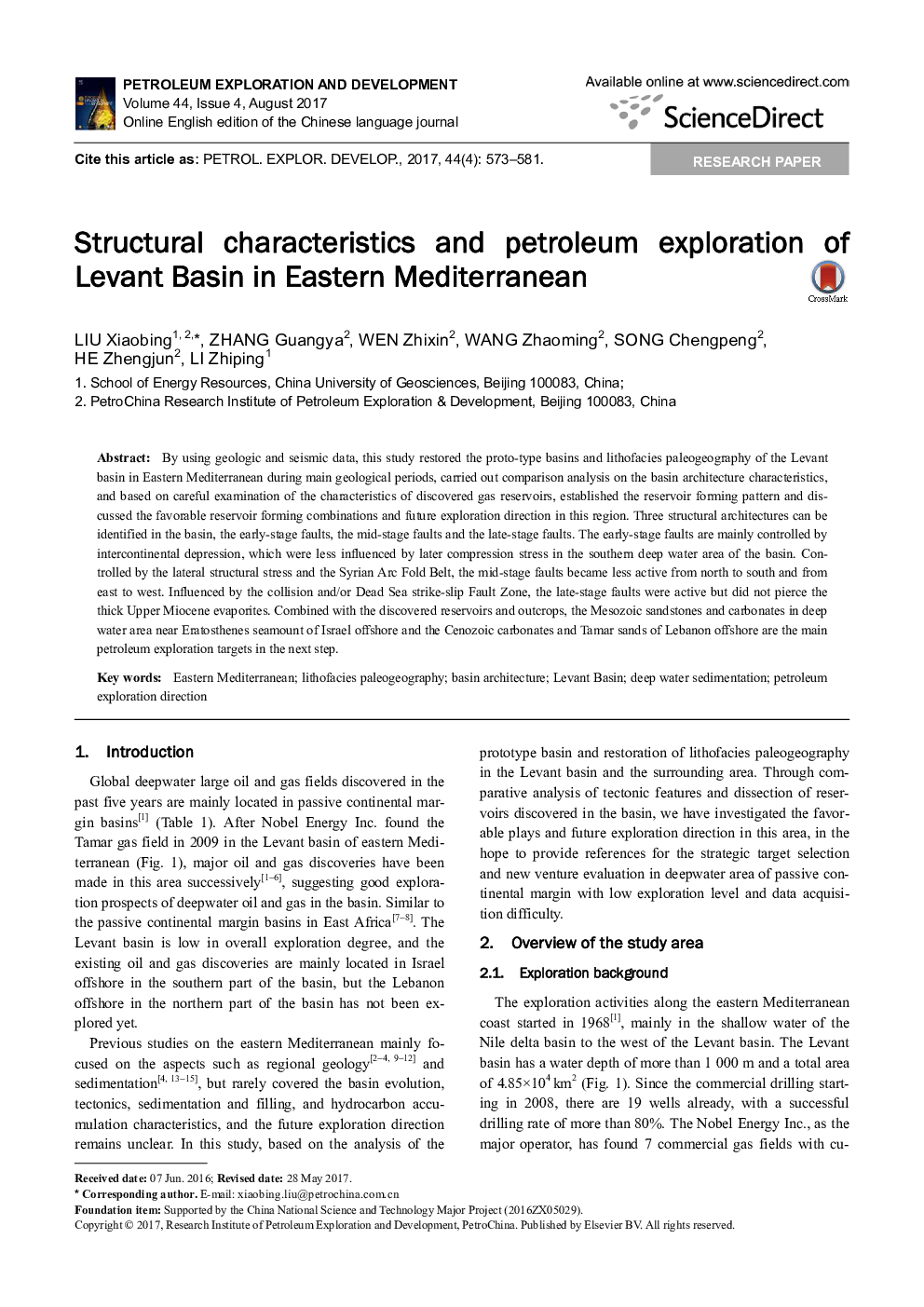| کد مقاله | کد نشریه | سال انتشار | مقاله انگلیسی | نسخه تمام متن |
|---|---|---|---|---|
| 8912237 | 1639326 | 2017 | 9 صفحه PDF | دانلود رایگان |
عنوان انگلیسی مقاله ISI
Structural characteristics and petroleum exploration of Levant Basin in Eastern Mediterranean
ترجمه فارسی عنوان
ویژگی های سازه ای و اکتشاف نفت در حوضه شبه جزیره دریای مدیترانه
دانلود مقاله + سفارش ترجمه
دانلود مقاله ISI انگلیسی
رایگان برای ایرانیان
کلمات کلیدی
مدیترانه شرقی، پالئوگرافی گیاهان لیتوفایی، معماری حوضه، حوضه لوانت، رسوب آب عمیق، جهت اکتشاف نفت،
ترجمه چکیده
با استفاده از داده های زمین شناسی و لرزه ای، این مطالعه با بهره گیری از داده های زمین شناسی و لرزه ای، حوضه های پروتئین و لاتوفسیوس پالئوگوگرافی حوضه لوانت را در دریای مدیترانه در طول دوره های زمین شناسی اصلی، تجزیه و تحلیل های مربوط به ویژگی های معماری حوضه انجام داد و بر اساس بررسی دقیق ویژگی های کشف شده مخازن گاز، الگوی مخزن را تاسیس کرده و در مورد مخازن مخزن مناسب تربیت شده و جهت اکتشاف آینده در این منطقه مورد بحث قرار گرفته است. سه معماری سازه در حوضه، گسل های مرحله اولیه، گسل های میانی مرحله و گسل های مرحله پایانی شناسایی می شوند. گسل های اولیه در مرحله عمدتا تحت تأثیر افسردگی بین قاره ای قرار می گیرند که کمتر تحت تأثیر تنش کمپوست در ناحیه آب های عمیق جنوب قرار گرفته اند. کنترل شده توسط استرس ساختاری جانبی و کمربند قوس سوریه، گسل های اواسط مرحله از شمال به جنوب و از شرق به غرب کمتر فعال بود. تحت تاثیر تصادف و / یا ناحیه غرق شدن اعتصاب دریای مرده دریای خزر، گسل های مرحله ای در اواخر فعال بودند، اما ضخامت های ضخیم غول پیکر بالا را سوراخ نکردند. همراه با مخازن کشف شده و دفع زباله ها، ماسه سنگ های مزوزوئیک و کربنات ها در ناحیه عمیق آب در نزدیکی اریاتوسن، ساحلی اسرائیل ساحلی، و کربناتهای سینوزوئیک و ماسه های تامار از دریای لبنان، اهداف اکتشاف اصلی نفت در مرحله بعدی است.
موضوعات مرتبط
مهندسی و علوم پایه
علوم زمین و سیارات
ژئوشیمی و پترولوژی
چکیده انگلیسی
By using geologic and seismic data, this study restored the proto-type basins and lithofacies paleogeography of the Levant basin in Eastern Mediterranean during main geological periods, carried out comparison analysis on the basin architecture characteristics, and based on careful examination of the characteristics of discovered gas reservoirs, established the reservoir forming pattern and discussed the favorable reservoir forming combinations and future exploration direction in this region. Three structural architectures can be identified in the basin, the early-stage faults, the mid-stage faults and the late-stage faults. The early-stage faults are mainly controlled by intercontinental depression, which were less influenced by later compression stress in the southern deep water area of the basin. Controlled by the lateral structural stress and the Syrian Arc Fold Belt, the mid-stage faults became less active from north to south and from east to west. Influenced by the collision and/or Dead Sea strike-slip Fault Zone, the late-stage faults were active but did not pierce the thick Upper Miocene evaporites. Combined with the discovered reservoirs and outcrops, the Mesozoic sandstones and carbonates in deep water area near Eratosthenes seamount of Israel offshore and the Cenozoic carbonates and Tamar sands of Lebanon offshore are the main petroleum exploration targets in the next step.
ناشر
Database: Elsevier - ScienceDirect (ساینس دایرکت)
Journal: Petroleum Exploration and Development - Volume 44, Issue 4, August 2017, Pages 573-581
Journal: Petroleum Exploration and Development - Volume 44, Issue 4, August 2017, Pages 573-581
نویسندگان
Xiaobing LIU, Guangya ZHANG, Zhixin WEN, Zhaoming WANG, Chengpeng SONG, Zhengjun HE, Zhiping LI,
